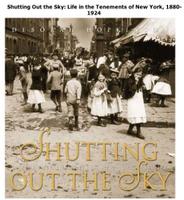 This is an excellent book by Deborah Hopkinson. Here's a review along two others that I recommend:Grade 5-8-Through the stories of five immigrants, the world of New York City's tenements in the late 19th and early 20th centuries comes alive with descriptions of the newcomers' struggles and triumphs as they attended night school, abandoned customs, or in other ways acclimated to life in America. Some came as children, others as teenagers, all eager either to succeed on their own or to help their families. Leonard Covello, who left Italy and arrived at Ellis Island with his mother and younger brothers six years after his father, became a high school principal. Pauline Newman began her working career in 1901 as a child laborer in the garment industry and later became one of the first women organizers of the International Ladies' Garment Workers' Union. Citing sources, Hopkinson quotes frequently from her subjects' and others' writing, and provides a detailed and intimate picture of daily life in Manhattan's Lower East Side. The text is supported by numerous tinted, archival photos of living and working conditions. Although this book will appeal to students looking for material for projects, the writing lends immediacy and vivid images make it simply a fascinating read.
This is an excellent book by Deborah Hopkinson. Here's a review along two others that I recommend:Grade 5-8-Through the stories of five immigrants, the world of New York City's tenements in the late 19th and early 20th centuries comes alive with descriptions of the newcomers' struggles and triumphs as they attended night school, abandoned customs, or in other ways acclimated to life in America. Some came as children, others as teenagers, all eager either to succeed on their own or to help their families. Leonard Covello, who left Italy and arrived at Ellis Island with his mother and younger brothers six years after his father, became a high school principal. Pauline Newman began her working career in 1901 as a child laborer in the garment industry and later became one of the first women organizers of the International Ladies' Garment Workers' Union. Citing sources, Hopkinson quotes frequently from her subjects' and others' writing, and provides a detailed and intimate picture of daily life in Manhattan's Lower East Side. The text is supported by numerous tinted, archival photos of living and working conditions. Although this book will appeal to students looking for material for projects, the writing lends immediacy and vivid images make it simply a fascinating read.Carol Fazioli, formerly at The Brearley School, New York City
Tenement: Immigrant Life on the Lower East Side
As the title suggests, Bial (The Underground Railroad) focuses this illuminating photoessay on the immigrants who settled on Manhattan's Lower East Side from the early 1800s to the 1930s. Rather than finding the fabled land of opportunity, many lived in poverty in rundown tenement flats plagued by poor ventilation, little light and inadequate sanitation. Through period photos as well as his own color shots (many taken at the Lower East Side Tenement Museum), the author describes and depicts typical cramped apartments. These two-room flats sometimes served as both living quarters (for a dozen or more people, often newly arrived relatives or paying boarders) and family "sweatshops." Bial touches on the sobering particulars: with no running water to allow residents to bathe or launder clothes properly, diseases were rampant, and so many babies died that tenements were known as "infant slaughterhouses." Historic photos, including many famous works by the reformer Jacob Riis, make the plight of these families startlingly real. Bial's conclusion, that most immigrants (or their children or grandchildren) eventually prospered, closes the volume on a positive note. Ages 8-12.
97 Orchard Street, New York: Stories of Immigrant Life
Gr 3-6-The Lower East Side Tenement Museum opened in New York City in 1994. "Urban archeology," "diligent research," and "interviews with former residents" facilitated the re-creation of this building that housed immigrants from the mid-1800s to its closing in 1935. Essentially a photo-essay of material from the museum, the text is divided into 13 brief sections beginning with "Mystery: The Gumpertz Family." Readers learn that "Julius Gumpertz walked out of the building-on a crisp October morning in 1874" never to be heard from again. Working as a seamstress, his wife managed to support her four young children, one of whom "died of diarrhea, an all-too-common fate for nineteenth-century infants." Each black-and-white photograph is accompanied by a detailed caption. Other sections introduce three more families and also tell their stories through artifacts and oral histories. Additional segments such as "Early Immigration" and "Ellis Island: Portal of Hope" deal with more general aspects of immigration at that time. Chock-full of the simple details of everyday life as well as larger tales of human joy and suffering, this volume presents an intriguing window into urban tenements just before and after the turn of the century. Be aware that there is no table of contents, no index, and the information presented does not follow a simple time line. However, the book is a useful addition to general collections, especially as a starting point for further investigation. Alicia Eames, New York City Public Schools






No comments:
Post a Comment